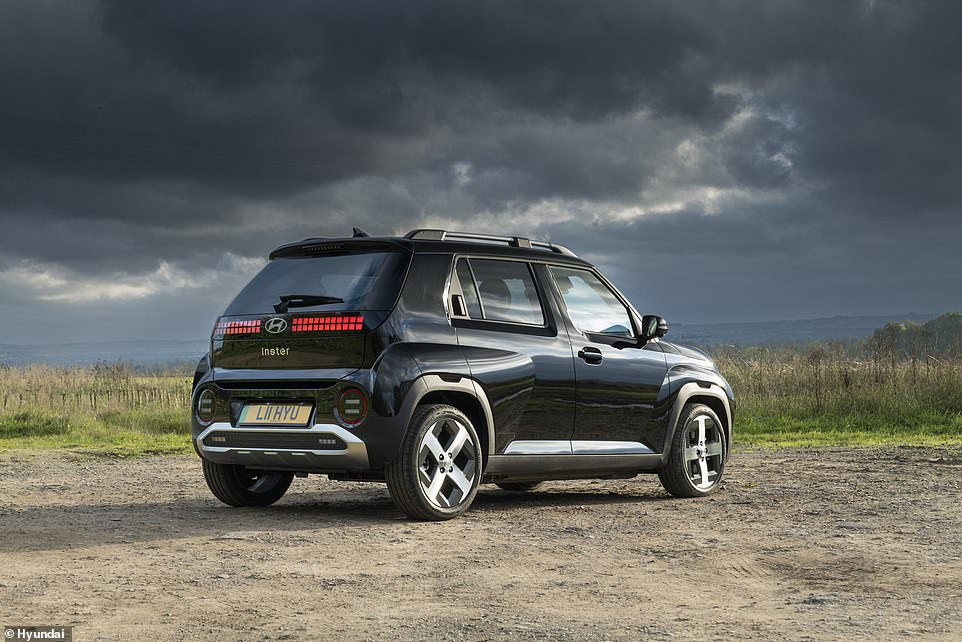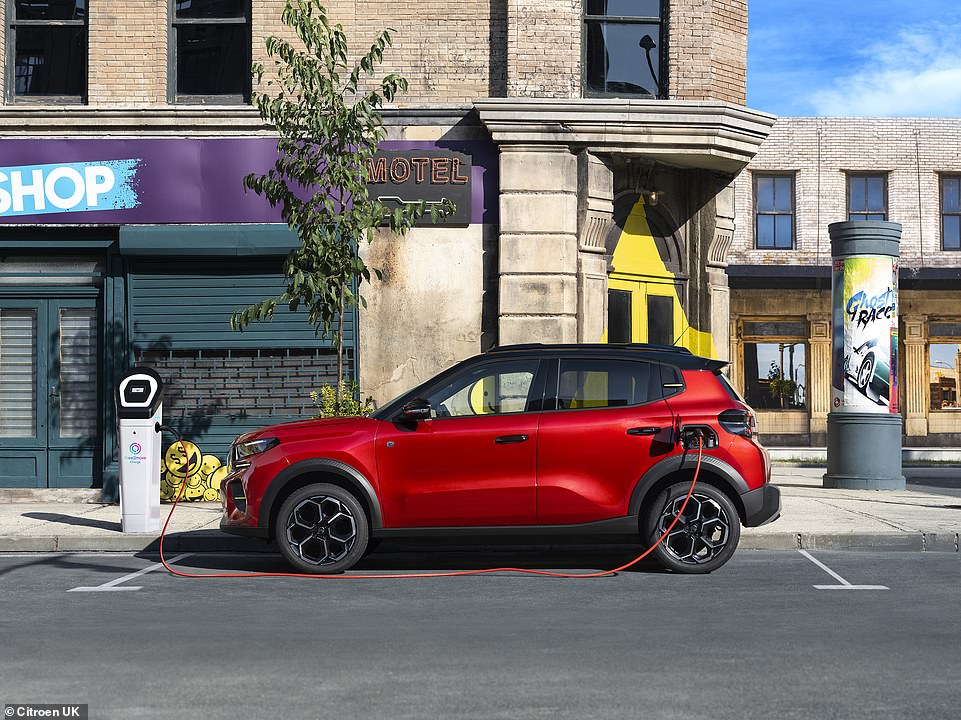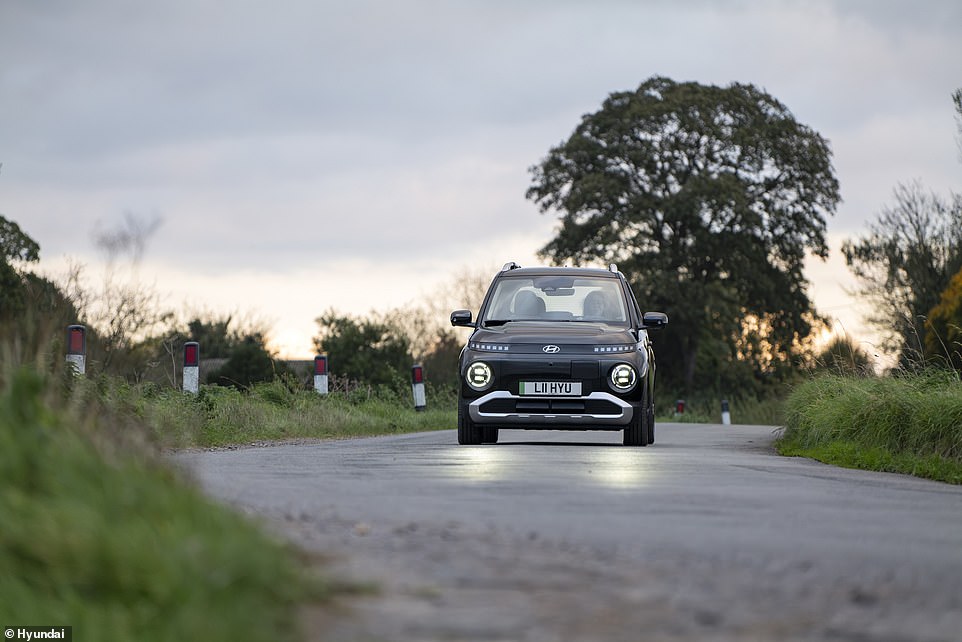Electric cars, they’re just too pricey.
That’s one of the big arguments put forward by drivers refusing to consider buying one right now.
But in recent months we’ve been given a glimpse of what a future with affordable battery-powered vehicles could look like with a flurry of small, silent models being unveiled.
Hyundai is the latest brand to join the budget EV conga line with its new Inster – a model the Korean brand says will ‘redefine ultra-small EVs’ thanks to a super-practical interior, bounty of big-car equipment and a party trick or two.
While it’s not due to arrive in the UK until mid-January, This is Money has been given early access to a pre-production prototype car on Oxfordshire’s country roads to determine if this could be the low-cost EV that changes Britain’s mind about finally ditching the internal combustion engine…

Could this be Britain’s first Inster-famous small EV? Hyundai’s new Inster is due to arrive in UK showrooms in January. But before it does, MailOnline and This is Money Motoring Editor Rob Hull has tested a pre-production example to see if it might be the ‘affordable’ electric car that changes Britain’s mind about finally ditching the internal combustion engine
The facts: What you need to know
First off the bat, this isn’t a brand-new car; Hyundai’s been selling it in Korea since 2021 under a different guise. And it’s only just recently converted it to an EV.
Called the ‘Casper’ (officially the company’s smallest ever model), it has been sold in Hyundai’s home nation with a 1.0-litre engine and a very modest starting price that converts to around £7,800. But for 2024, it’s been retrofitted with an electric drivetrain and rebranded for the European market (though still produced in a Korean factory).
Hyundai hasn’t just tinkered with the namebadge (clearly trying to appeal to Gen Z social media fans); it’s also tweaked the styling with EU customers in mind. But more on that later.

The Inster isn’t actually that new. It has been sold – with a petrol engine – as the Casper in Hyundai’s home nation, Korea. And it has proved incredibly popular

It will initially be available in the UK in two guises: Standard Range with a 42kWh battery, 71kW electric motor and range of 186 miles; and Long Range with a larger 49kWh battery pack, more potent 86kW e-motor and 229 miles of full-charge driving

To keep things simple, only two trim levels are available: 01 and 02. However, the level of equipment even in the most basic specification is extensive
In the UK, it will be sold with two drivetrain options: Standard Range with a 42kWh battery, 71kW electric motor and range of 186 miles; and Long Range with a larger 49kWh battery pack, more potent 86kW e-motor and 229 miles of full-charge driving.
Their respective starting prices: £23,495 and £25,045. Not exactly cheap then, is it?
They share the same 11kW on-board charger, battery heating system and high-efficiency heat pump. As such, charging from 10 to 100 per cent using an 11kW wallbox at home takes around four hours (4hrs 35mins for the Long Range). And when you’re caught short for range en route, a half-hour blast on a 150kW ultra-rapid public device will top it up from 10 to 80 per cent capacity.
To keep things simple, only two trim levels are available: 01 and 02.
Basic equipment is extensive: 15-inch alloy wheels, a 10.25-inch digital instrument cluster and same-size touchscreen infotainment display with navigation, Apple CarPlay and Android Auto connection (though not wireless), rear parking sensors with rear view camera, cruise control, auto headlights and keyless entry. Air conditioning with climate control is standard too, as are heated door mirrors.
Pay an extra £1,700 for the 02 spec and you get bigger 17-inch alloys, front parking sensors, the same heated multifunction steering wheel with LED lights you find in a Kona Electric, heated front seats and a wireless charging pad for your smartphone.

Fast charging using a 150kW public device will see the battery upped from 10% to 80% in half an hour. Using a home wallbox, it’s closer to four hours for a near full charge (10-100%)
Hyundai’s also equipped it with the full suite of driver assistance tech it bestows its much bigger cars. Forward collision avoidance assist, lane keep assistance, blind spot warning and driver attention monitoring; all of it is crammed into this compact package as standard.
In terms of dimensions, Inster falls into the ‘A Segment’ category, which is the smallest there is. Think Fiat 500, Toyota Aygo and VW Up! for reference.
At 3,825mm long, it’s about a metre shorter than an average UK parking space. And at 1,610mm (excluding the mirrors), it’s 80cm narrower too – so no fear of clattering its doors into the motor next to you at Asda or Tesco.
However, it’s the height department where Inster is blessed; at 1,575mm, it’s on par with a Nissan Juke crossover but without the jacked-up suspension.
First UK customers can expect to take delivery in early February and a rugged-looking Inster Cross is due later in 2025, offering barely any off-road capability but some outdoorsy features, including a ‘roof basket’ – at a premium price, of course.
An onslaught of affordable EVs: What will Inster’s competition be?
Just like buses, we’ve been waiting for what feels an eternity for a budget-friendly EV to show up – then they’ve all come along at once. So, here’s a whistle-stop tour of rivals the Inster will go head-to-head with in the next couple of years.
Let’s start with the cheapest of all, the Dacia Spring. Launched earlier in 2024, it is priced from just £14,995 in the UK. It comes with a 26.8kWh battery and range up to 140 miles.
Not bad for £15k, right? Well, there is one issue: questionable crash protection. When safety body Euro NCAP tested one in 2022, it came back with scores of just 49 per cent for Adult Occupant protection and a mere 56 per cent for Child Occupant shielding.

Had the Inster been launched a year ago, Hyundai wouldn’t have any competition in this compact EV segment. But today, there’s quite a lot of choice, including the £15,000 Dacia Spring. However, the Romanian electric car does have a major sticking point…

Leapmotor’s T03 is a newcomer from China with a £16,000 asking price. That’s genuinely cheap by new car standards, but it is a bit of a red herring for now

Arguably the most direct rival to the Hyundai Inster is the new Citroen e-C3, which costs from £22,000. It has similarly boxy proportions and a decent range

The Fiat 500e is the old guard of the competition, but we consider it a genuine rival because the Italian brand is currently shaving £3,000 off the RRP, meaning it starts from £22,000 today
How about the next option from newcomer Leapmotor? It’s a Chinese car firm you’ve probably never heard of but one that’s just done a deal with Fiat and Vauxhall’s parent group Stellantis so the £15,995 T03 can be sold in the UK.
It has a 37.3kWh battery pack and range of 165 miles. But is a bit of an unknown entity. Think of it as the red herring of the Inster’s competition.
Next on the list is Citroen’s e-C3. Ah, a brand you do know. It’s quite a significant jump in price, on sale now from £21,990, Battery size is almost on par with the Hyundai at 44kWh, offering a range of 199 miles.
You can also throw the Fiat 500e (44kWh battery and 199-mile range) into the mix, when taking into account the £3,000 ‘E-Grant’ subsidy bringing the price down to £21,995. That said, the grant is due to expire at the end of the year.
Glance a little further into the distance and Skoda and Volkswagen promise their own compact EV offerings – the Epiq and ID.2 respectively – both of which should ring in around £22k and provide driving ranges in excess of 200 clicks.
It means the Inster is likely to be the priciest of the lot.


Side-by-side, you can see how Hyundai’s design team has tried to replicate some of the bigger Ioniq5’s (left) features in the much dinkier Inster (right)
Honey, I shrunk the Ioniq5!
Now, to the most pointless section of any car review – discussing its looks. With beauty in the eye of the beholder, I’m only going to talk facts, not subjective opinion on styling.
Despite measuring in around 20mm longer than the Casper, it has the same silhouette: tall, short overhangs front and back, and curves that have been drawn with a ruler. Boxy, it definitely is.
Hyundai hasn’t steered too far away from its Korean cousin’s features either: the Inster’s oval LED lights with headlamps set inside, squared-off window frames, right-angled arches, bulging rear wings and roof bars are all carried over.
Where the design team tasked with tailoring it to European customers have [barely] earned their wages is the addition of the pixel cluster lights you’ll recognise from Hyundai’s Ioniq 5. The ones at the front are just indicators; to the rear it’s the full shebang.
While this keeps the design language consistent with electric Hyundais we’re accustom too, these retrofitted panels feel a little flimsy and plasticky when prodded.
Where we will pay compliment is the placement of the charging port – at the front, where it is most practical.

Once seated, you’ll be basking in feline-swingable space thanks to its Tardis-like qualities. Up front, it feels anything but cramped with an abundance of head room and a clever bench-seat design

Generally speaking, all the switches feel durable. And while there are scatterings of hard plastic, the major touchpoints – like the insets for the door cards – are padded and enjoyably tactile. Even the inside of the metal door handles have grooves in them so you can grip easier
The Tardis of small EVs
No matter what your opinion on the exterior, I’m pretty confident most customers in this market will be bowled over by the practicality and quality of Inster’s cabin.
Once seated, you’ll be basking in feline-swingable space thanks to its Tardis-like qualities.
Up front, it feels anything but cramped with an abundance of head room.
A clever seating design also provides a wider driver’s chair base that moulds against the passenger seat to form a bench. Not only is this comfortable for individuals of larger proportions but will also help you get out of a tight squeeze; if the driver’s door were to be pinned shut by an inconsiderate motorist parking too close, you can easily shuffle across to exit on the other side.
My only critique is the double cup holder positioned within the bench seat. Use these to transport boiling hot beverages with loose lids at your peril!

My one major gripe with the front seats is the very low cup holders. Use these to transport boiling hot beverages at your peril

For such a small car, there’s an incredible amount of leg room in the back. This image is with the clever sliding rear seats in their furthest-back position. With no transmission tunnel (which you find in petrol and diesel cars) running down the centre of the interior, there is genuinely more than enough space for six footers to sit comfortably
Even with a six-footer at the wheel, adults of above-average height aren’t going to be wanting for space in the back either – granted you can only transport two of them (it’s too skinny to have a narrow third middle seat).
This is partly thanks to the raised ceiling and a clever sliding rear seat setup that Hyundai has pinched from the first-generation Toyota Yaris from 1999. It allows users to choose between having extra rear legroom or a more capacious boot compartment. Unfortunately, it is only available on the higher 02 trim, though I think the flexibility it offers is worth every penny of the additional £1,700 outlay.
The quality of the cabin is impressive, too. Our EU-spec prototype is equivalent to a UK 02 trim (minus the electric sunroof, which unfortunately won’t be available in either trim level). It has lovely houndstooth fabric seats, which, I imagine, are far nicer than black cloth you get as standard.
The higher-grade trim also has the choice of 64 ambient lighting options. Unfortunately, our test car had this deactivated, quickly extinguishing my excitement at the prospect of turning the Inster into a miniature nightclub on wheels.
Generally speaking, the switches all feel durable enough to survive the test of time and while there are scatterings of hard plastic, the major touchpoints – like the inserts for the door cards – are padded and enjoyably tactile. Even the inside of the metal door handles have grooves in them so you can grip easier.
None of it feels cheap in any way.
And the same can be said about the displays.

The driver’s cluster is clear and has adjustable settings so you can flutter between classic dials, more futuristic clocks and racier instruments

The infotainment screen, while still a little buggy in this pre-production example, has a simple menu layout and felt responsive enough for a vehicle at this price point

Fortunately, Hyundai has taken a commonsense approach to the main controls by using buttons rather than bunching the functions in the infotainment screen
The driver’s cluster is clear and has adjustable designs so you can flutter between classic dials, more futuristic clocks and racier instruments.
The infotainment screen, while still a little buggy in this pre-production example, has a simple menu layout and felt responsive enough for a vehicle at this price point.
Fortunately, Hyundai hasn’t fallen into the trap of bundling all of the main control functions into the touchscreen, instead sticking to the old-school format of easy-to-reach buttons for temperature settings and audio adjustment. Bravo!
Hidden at the bottom of the centre console are the controls to operate Vehicle-to-load (or V2L), which switches the Inster’s battery into an energy source to power your electronic devices, like a kettle or laptop. The Dacia Spring has this too, but it’s still surprising to see the feature on another budget-end EV.

With the rear seats slide as far back as possible, there’s a limited 238 litres of boot space. However, compromise on rear passenger legroom and it can extend to 351 litres, which is far more useable
In terms of the boot, it’s not the same tale of space. At 238 litres as standard, any thought of transporting a suitcase will quickly go out the window. However, if you’ve chosen the 02 trim with the sliding rear bench, you can extend the compartment to a far more usable 351 litres (granted your rear-seat passengers won’t thank you for doing so).
A hidden under floor section is there too, but this will mostly be occupied by the charging cables.
Fold the back seats completely flat and the luggage capacity explodes to 1,059 litres. And if you’ve opted for the pricier spec, you can also fold the front seats too (though you will need to remove the headrests first).
This is the Inster’s big party piece. With all the seats flush, you can fit a mattress over the top and use it as a two-birth motorhome. How many owners plan to sleep in their Insters, I’m not sure.
Here’s the Inster’s party trick: All four seats can be folded flat to provide a completely flat area – ideal for sleeping if you have a roll-out lightweight mattress. It should be around the size of a king-size bed
How does it drive?
Given that I was entrusted with a pre-production car not in UK specification, the bods at Hyundai urged caution that this particular example might not drive or have the battery performance of those arriving in UK showroom in three months’ time.
But an hour-and-a-half behind the wheel is still enough to build an impression of how dynamically capable the Inster will be.
First things first, lots of adjustment in the steering column (reach and height) and seat means finding the prime driving position for any stature is a doddle. Many small cars tend to scrimp in this department, so it should be applauded here.

While it won’t be winning drag races anytime soon, the Inster’s acceleration is usable in the real world. When departing a 30mph zone for a national speed limit, a punch of the throttle has you effortlessly pulling away from combustion engine cars behind. So, it’s quick enough

Having a battery anchor such a small car to the road does make the Inster feel surprisingly stable in the corners, even despite its lanky body. A few circulations of roundabouts at pace failed to trigger understeer, body-roll or the car to pitch to one side
Now on the move, let’s first turn attention to acceleration, which, by EV standards, is pedestrian on paper.
The Long Range version I drove has a slightly quicker 0-to-62mph sprint time of 10.6 seconds (versus 11.7 in Standard Range), so it doesn’t take off at warp-speed like something more potent, say a Tesla Model 3. That’s no bad thing – especially for a car designed primarily for use in urban settings.
While it won’t be winning drag races anytime soon, its usable in the real world. When departing a 30mph zone for a national speed limit, a punch of the throttle has you effortlessly pulling away from combustion engine cars behind. So, it’s quick enough, I think.
Top speed is restricted to 93mph (87mph in Standard Range), but you’ll never need – or want – to put this statistic to the test.
At lower speeds, the cabin acoustics do an adequate job of making the interior feel cossetted. However, from 50mph and above, tyre and wind noise both begin to intrude into the cockpit – and I imagine at motorway speed it could become quite a rowdy affair.

Inster’s suspension is most definitely on the firm side. Small imperfections in the tarmac, like a shallow pothole or rumble strip, are dealt with adequately but more pronounced speed bumps can fling you around in your seat
In terms of ride comfort, it’s definitely on the firm side. Small imperfections in the tarmac, like a shallow pothole or rumble strip, are managed quite well. However, approaching anything more pronounced – like one of those raised square speed hump islands – at anything but a crawl will fling you around in your seat.
This, I believe, is a consequence of the larger 17-inch wheels on this 02-spec test car, heavy batteries laden into the floor and inexpensive suspension components pushed beyond their capabilities of ironing out these effects.
However, having a battery anchor such a small car to the road does make the Inster feel surprisingly stable in the corners, even despite its lanky body.
A few circulations of roundabouts at pace failed to trigger understeer, body-roll or the car to pitch to one side.
Steering, while far from engaging, is effortlessly light, and the brakes offer decent levels of bite despite the typical initial sponginess from a regenerative system.
Finally, front three-quarter visibility is pretty good, though over-the-shoulder checks are met with a thick C-pillar at the back, which isn’t ideal in some scenarios, like trying to navigate a motorway entry slip road.

While the Inster is impressive roomy and packed with kit, the truth is that a starting price of £23,500 isn’t going to be cheap enough to convince Britain’s general car-buying public to dip into their own purses
Hyundai Inster: The Cars & Motoring Verdict
Without question, the Inster is an impressive package. For such a small car, it’s hugely roomy and loaded with quality materials and kit you’d usually expect to find in bigger cars.
But this latter point, I fear, might also be its downfall.
Had Hyundai done away with some of the somewhat unnecessary features for a compact car, they could have created an EV that’s truly affordable.
Because the vast majority of electric car drivers are financing or leasing their motors, a model’s residual value (which determine how much you pay over the contracted period) arguably becomes more important than its list price. And with more equipment typically comes slower depreciation, hence why it’s so fully loaded.
But had the company scaled back luxuries like V2G, heated steering wheel, two digital displays and so forth, the Inster might possibly have boasted a starting price closer to petrol city cars (Dacia’s Sandero is the cheapest from £13,795) and what is sure to be its biggest rival, the £15k Dacia Spring.
The truth is £23,500 really isn’t cheap for such a small vehicle, especially if you’re expecting the general car-buying public to dip into their own purses – and when the competition is some £8,500 less expensive.
As such, Hyundai’s latest arrival probably won’t be Inster-famous in Britain.
CARS & MOTORING: ON TEST
-
 Hyundai Inster review: Is it the affordable EV we’ve been waiting for?
Hyundai Inster review: Is it the affordable EV we’ve been waiting for? -
 The most controversial new car of 2024: We drive the Ford Capri EV
The most controversial new car of 2024: We drive the Ford Capri EV -
 Aston Martin Vanquish: Britain’s new brute of a sports car tested
Aston Martin Vanquish: Britain’s new brute of a sports car tested -
 Renault 5 EV: Can it recreate the character and charm of the original?
Renault 5 EV: Can it recreate the character and charm of the original? -
 Polestar 4 EV: The first car sold in Britain WITHOUT a rear window
Polestar 4 EV: The first car sold in Britain WITHOUT a rear window -
 We take to the wheel of Ferrari’s stunning new £336k 12Cilindri GT car
We take to the wheel of Ferrari’s stunning new £336k 12Cilindri GT car -
 China’s new sub-£16k EV: Leapmotor T03 arrives in UK with low price
China’s new sub-£16k EV: Leapmotor T03 arrives in UK with low price -
 Peugeot E-5008: Is the £49k SUV the choice for eco-conscious families?
Peugeot E-5008: Is the £49k SUV the choice for eco-conscious families? -
 Ducati’s new £30,000 Panigale V4 S costs the same as a small Mercedes
Ducati’s new £30,000 Panigale V4 S costs the same as a small Mercedes -
 Is the new £22k MG ZS hybrid family-friendly SUV a genuine bargain?
Is the new £22k MG ZS hybrid family-friendly SUV a genuine bargain? -
 This £100k Volvo has driven me to distraction: EX90 SUV driven
This £100k Volvo has driven me to distraction: EX90 SUV driven -
 VW Touareg is a luxury SUV for a lower price – why is it so unpopular?
VW Touareg is a luxury SUV for a lower price – why is it so unpopular? -
 We test the new MG HS – Britain’s favourite budget-friendly family SUV
We test the new MG HS – Britain’s favourite budget-friendly family SUV -
 We test drive the £15,000 Dacia Spring – the UK’s CHEAPEST new EV
We test drive the £15,000 Dacia Spring – the UK’s CHEAPEST new EV -
 Suitable for UK climates: You can enjoy Mercedes CLE Cabrio year round
Suitable for UK climates: You can enjoy Mercedes CLE Cabrio year round -
 Kia’s affordable Picanto offers a fun and nippy drive in the big city
Kia’s affordable Picanto offers a fun and nippy drive in the big city -
 MG Cyberster review – convertible EV costs £60k and is fun to drive
MG Cyberster review – convertible EV costs £60k and is fun to drive -
 ‘Euros’ winning Renault Scenic E-Tech gets Ray Massey’s vote
‘Euros’ winning Renault Scenic E-Tech gets Ray Massey’s vote -
 Ford Explorer: Is the £40k electric SUV a good buy for UK drivers?
Ford Explorer: Is the £40k electric SUV a good buy for UK drivers? -
 Polestar 3: Does the Tesla Model Y now have a real fight on its hands?
Polestar 3: Does the Tesla Model Y now have a real fight on its hands? -
 Lotus Eletre is an EV Lamborghini Urus rival: The hyper-SUV tested
Lotus Eletre is an EV Lamborghini Urus rival: The hyper-SUV tested -
 Dacia’s new Duster is here – has it lost its value-for-money appeal?
Dacia’s new Duster is here – has it lost its value-for-money appeal? -
 Alfa Romeo Tonale review: Can this SUV bring some sporting thrill?
Alfa Romeo Tonale review: Can this SUV bring some sporting thrill? -
 In a world of SUVs, can the VW Passat re-energise the estate market?
In a world of SUVs, can the VW Passat re-energise the estate market? -
 Ineos Quartermaster review: The new premium pick-up truck in town
Ineos Quartermaster review: The new premium pick-up truck in town -
 Peugeot e-3008 is attractive, sprightly and has a 326-mile range
Peugeot e-3008 is attractive, sprightly and has a 326-mile range -
 New £165k Aston Martin Vantage tested – is it better than a Ferrari?
New £165k Aston Martin Vantage tested – is it better than a Ferrari? -
 Can BMW harness the magic of the original Mini in an EV made in China?
Can BMW harness the magic of the original Mini in an EV made in China? -
 Is this the ultimate open-top super tourer? Aston Martin DB12 Volante
Is this the ultimate open-top super tourer? Aston Martin DB12 Volante -
 New Fiat 600e EV family car is here, but should wait for the hybrid?
New Fiat 600e EV family car is here, but should wait for the hybrid? -
 VW Tiguan review: Brand’s best-selling SUV is back – but is it better?
VW Tiguan review: Brand’s best-selling SUV is back – but is it better? -
 Should you consider the Mini Countryman EV instead of the petrol?
Should you consider the Mini Countryman EV instead of the petrol? -
 Another BMW goes electric – we test the new iX2 vs its petrol X2 rival
Another BMW goes electric – we test the new iX2 vs its petrol X2 rival -
 The 2024 Range Rover Evoque plug-in hybrid is a home-grown winner
The 2024 Range Rover Evoque plug-in hybrid is a home-grown winner -
 Britain’s favourite car DRIVEN – we review the best-selling Ford Puma
Britain’s favourite car DRIVEN – we review the best-selling Ford Puma -
 BMW’s i5 EV offers supercar performance in an exec saloon package
BMW’s i5 EV offers supercar performance in an exec saloon package -
 We drive the £76,000 Kia EV9 – Korea’s all-electric Range Rover rival
We drive the £76,000 Kia EV9 – Korea’s all-electric Range Rover rival -
 Has the BMW M3 Touring been worth the three-decade wait? Our review
Has the BMW M3 Touring been worth the three-decade wait? Our review -
 Has Britain’s most popular small car just got much better? New Corsa
Has Britain’s most popular small car just got much better? New Corsa -
 Volvo EX30 review: Sweden’s new ‘green’ pocket rocket SUV rival Tesla
Volvo EX30 review: Sweden’s new ‘green’ pocket rocket SUV rival Tesla -
 Is Renault’s new Austral E-Tech SUV the complete package? We drive it
Is Renault’s new Austral E-Tech SUV the complete package? We drive it -
 The Audi Q8 is annoyingly good for a ‘sporty’ coupe-style SUV
The Audi Q8 is annoyingly good for a ‘sporty’ coupe-style SUV -
 Ferrari Roma Spider costs £210k – here’s what you get for your money
Ferrari Roma Spider costs £210k – here’s what you get for your money -
 China’s all-electric BYD Dolphin lands ashore – we test it on UK roads
China’s all-electric BYD Dolphin lands ashore – we test it on UK roads -
 Our epic road test through Demark and Sweden in the new Polestar 2
Our epic road test through Demark and Sweden in the new Polestar 2 -
 New Abarth 500e convertible is a rare treat – it’s electric and sporty
New Abarth 500e convertible is a rare treat – it’s electric and sporty -
 Honda’s new CR-V is bigger than its predecessor – but is it better?
Honda’s new CR-V is bigger than its predecessor – but is it better? -
 We beat the new Bond to test his new car: Aston Martin DB12 review
We beat the new Bond to test his new car: Aston Martin DB12 review -
 Behind the wheel of Rolls-Royce’s Spectre: We test the new EV Roller
Behind the wheel of Rolls-Royce’s Spectre: We test the new EV Roller -
 Skoda’s crowning glory: Superb L&K 4×4 Estate with extras driven
Skoda’s crowning glory: Superb L&K 4×4 Estate with extras driven -
 Maserati Grecale test – the SUV with 50% of sales projected for women
Maserati Grecale test – the SUV with 50% of sales projected for women -
 Dacia’s budget family car with seven seats! The £18,000 Jogger tested
Dacia’s budget family car with seven seats! The £18,000 Jogger tested -
 This Q8 is just great: We take Audi’s new Sportback e-tron for a spin
This Q8 is just great: We take Audi’s new Sportback e-tron for a spin -
 Enter the Dragon! BYD Atto EV is the Chinese company’s first UK model
Enter the Dragon! BYD Atto EV is the Chinese company’s first UK model -
 Ferrari’s first four-door family car: New £313,000 Purosangue driven
Ferrari’s first four-door family car: New £313,000 Purosangue driven -
 Thrills without frills: £31,000 MG5 is one of the cheapest family EVs
Thrills without frills: £31,000 MG5 is one of the cheapest family EVs -
 Renault’s Arkana ticks all the boxes for what car-buying Britons want
Renault’s Arkana ticks all the boxes for what car-buying Britons want -
 Can Peugeot’s chic 408 hybrid crossover be a hit in the UK? We test it
Can Peugeot’s chic 408 hybrid crossover be a hit in the UK? We test it -
 We drive the Civic Type R – the rebellious bad boy in Honda’s line-up
We drive the Civic Type R – the rebellious bad boy in Honda’s line-up -
 Rolls Royce Spectre: What’s it lke to drive the first ELECTRIC Roller?
Rolls Royce Spectre: What’s it lke to drive the first ELECTRIC Roller? -
 Ineos Grenadier driven: Sir Jim Ratcliffe’s £69,000 Defender
Ineos Grenadier driven: Sir Jim Ratcliffe’s £69,000 Defender -
 Can you really live with a tiny Citroen Ami? Seven tasks in seven days
Can you really live with a tiny Citroen Ami? Seven tasks in seven days -
 Don’t supersize me! Is the ‘smaller’ Volvo XC60 all the SUV you need?
Don’t supersize me! Is the ‘smaller’ Volvo XC60 all the SUV you need? -
 We pamper some passengers in the new £211k Bentley Bentayga
We pamper some passengers in the new £211k Bentley Bentayga -
 New kind of Buzz! VW’s electric MPV still feels like a hippy campervan
New kind of Buzz! VW’s electric MPV still feels like a hippy campervan
Some links in this article may be affiliate links. If you click on them we may earn a small commission. That helps us fund This Is Money, and keep it free to use. We do not write articles to promote products. We do not allow any commercial relationship to affect our editorial independence.











